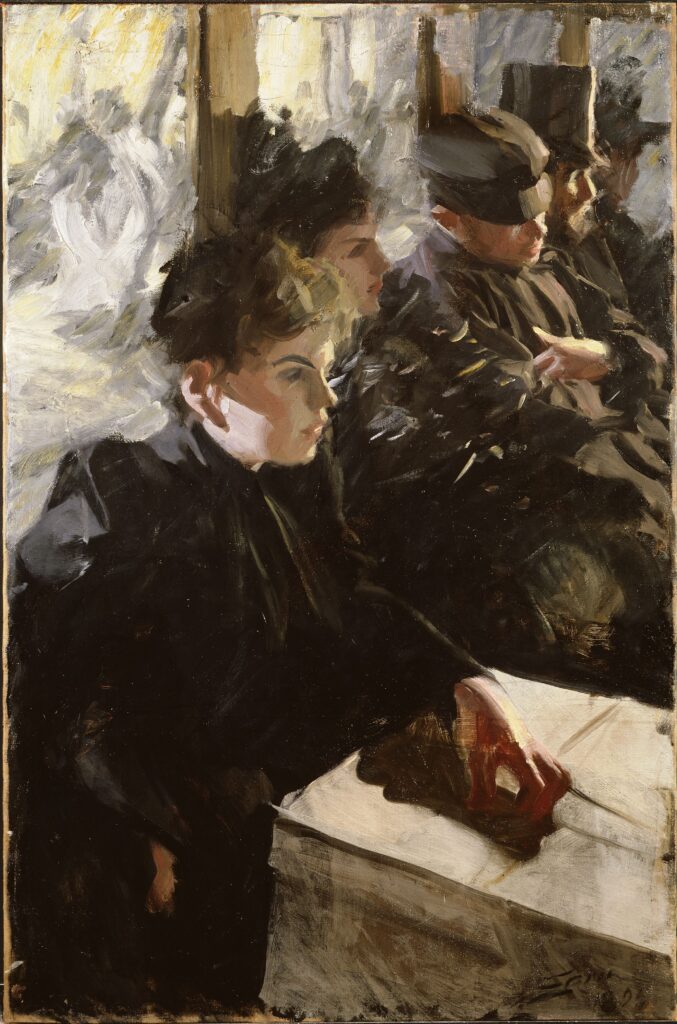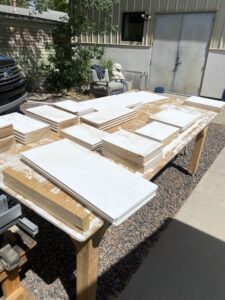As artists, we’re often drawn to the allure of a vast array of colors. Art supply stores tempt us with rows upon rows of vibrant hues, each promising to unlock new realms of creative expression. But what if I told you that the key to truly mastering color lies not in having more options, but in purposefully limiting your choices?
A time-honored approach to painting that has been embraced by masters throughout history and continues to be a valuable tool for artists of all skill levels today. In this post, we’ll explore the numerous benefits of working with a limited palette, learn about some popular limited palette options, and showcase inspiring examples from artists who have created stunning works with just a handful of colors.
(This post includes affiliate links! If you make a purchase through one of these links, it won’t cost you anything extra. You pay the same amount, but I earn a modest commission that supports the maintenance of this platform. Your support is greatly appreciated!)
Why Embrace Limitation?
Improved Color Harmony
When you work with a limited palette, you’re forced to mix and blend your available colors to create new hues. This process naturally results in a more harmonious overall color scheme, as all the colors in your painting are derived from the same few parent colors. The result is a cohesive and pleasing visual experience for the viewer.
Enhanced Color Mixing Skills
Nothing hones your color mixing abilities quite like working with a limited palette. When you can’t reach for a pre-mixed green or purple, you’ll quickly learn how to combine your primary colors to achieve the exact shade you need. This skill is invaluable for any artist and will serve you well even when you return to a more extensive palette.
Faster Decision Making
With fewer color options at your disposal, you’ll spend less time deliberating over which hue to use next. This can lead to a more intuitive and fluid painting process, allowing you to focus on other aspects of your work such as composition, value, and brushwork.
Consistent Style Across a Body of Work
Using a limited palette across multiple paintings can help create a cohesive look for a series or exhibition. This consistency can be particularly appealing to collectors and galleries.
Cost-Effective
Let’s face it – quality art supplies can be expensive. By focusing on a select few colors, you can invest in higher-quality paints without breaking the bank.
Portability
Whether you’re plein air enthusiast or simply like to sketch on the go, a limited palette means less gear to carry around. This can be especially beneficial for traveling artists or those who enjoy urban sketching.
Historical Connection
Many of the great masters throughout art history worked with limited palettes, either by choice or due to the limited pigments available at the time. By exploring this approach, you’re connecting with a rich artistic tradition.
Popular Limited Palettes
Now that we’ve covered the “why,” let’s explore some well-known limited palettes that you can experiment with in your own work and remember that you can always come up with your own versions:
1. The Zorn Palette
Named after the Swedish artist Anders Zorn, this palette consists of just four colors:
– Vermilion (or Cadmium Red or sometimes Alizarin Crimson)
Despite its simplicity, the Zorn palette is capable of producing a surprisingly wide range of hues, particularly well-suited for portraits and figurative work. The combination of yellow ochre and black can create convincing greens, while the red and black mix to form rich purples.
2. The Primary Palette
As the name suggests, this palette uses the three primary colors plus white:
This palette is excellent for teaching color theory and mixing, as it requires the artist to create all secondary and tertiary colors from scratch.
In my personal experience, this is the palette that taught me color mixing, as recommended by a cherished mentor when I was just starting out, it became my constant companion for three formative years.
More than just a tool, this palette was my silent instructor in color mixing, marking my evolution from novice to confident colorist.
Through countless hours of experimentation and enormous piles of “useless” paint, I learned to speak the language of hue, value, and chroma.
To fellow artists: find your own ‘teacher.’ Let it challenge you, frustrate you, and ultimately, transform your craft. The right tool can be the key to unlocking your artistic potential.
3. The Earth Tone Palette
Perfect for landscape painters, this palette focuses on natural, muted tones:
4. The Verdaccio Palette
Historically used for underpainting in Renaissance portraits, this green-toned palette consists of:
5. The Split-Primary Palette
A slightly expanded option that still maintains limitations:
This palette offers a “warm” and “cool” version of each primary color, allowing for more nuanced mixing while still keeping options limited.
A lot of these palettes include paints containing cadmiums and if that is something which you would like to avoid, there are other alternatives. Go to my previous blogpost: Transitioning from Cadmiums to learn more.
Why Limited Palettes are Great for Beginners
If you’re just starting your artistic journey, a limited palette can be an invaluable learning tool:
Simplifies the Learning Process
With fewer colors to manage, beginners can focus on fundamental skills like value, composition, and brushwork without being overwhelmed by color choices.
Teaches Color Theory Through Practice
Mixing colors becomes a necessity rather than an option, helping new artists internalize color relationships and how different hues interact.
Builds Confidence
Successfully creating a wide range of colors from a limited set of paints can be incredibly empowering for novice artists.
Encourages Observation
Working with a limited palette forces artists to really look at the colors in their subject and figure out how to recreate them with the available hues.
Develops Problem-Solving Skills
When you don’t have the exact color you need, you’ll learn to improvise and find creative solutions – a valuable skill for any artist.
Examples of Stunning Artwork Created with Limited Palettes
To truly appreciate the potential of limited palettes, let’s look at some artists who have created remarkable work using this approach:
1. Anders Zorn
The namesake of the Zorn palette, this Swedish artist’s portraits and figurative works demonstrate the rich possibilities of his four-color approach. His painting “Omnibus” (1892) is a prime example, showcasing a range of flesh tones and atmospheric effects achieved with minimal colors.

2. John Singer Sargent
While Sargent didn’t always stick to a strict limited palette, many of his portraits show a restrained use of color. His famous “Madame X” (1884) uses a primarily monochromatic scheme with carefully chosen accents, creating a striking and memorable image.

3. Joaquín Sorolla
The Spanish master was known for his luminous beach scenes, many of which were painted with a palette similar to the Zorn. His work “Walk on the Beach” (1909) demonstrates how a limited palette can still capture the bright, sun-drenched atmosphere of a seaside scene.

4. Richard Schmid
A more contemporary example, Schmid’s book “Alla Prima II” advocates for the use of a limited palette. His landscape “Baranof Falls” shows how a carefully chosen set of colors can create vibrant, life-like results.

5. Mark Rothko
Mark Rothko’s large-scale color field paintings often utilize limited palettes to create powerful emotional experiences. By focusing on a few closely related colors, Rothko’s work evokes deep emotional responses and highlights the subtle variations within a narrow range of hues.
Rothko’s approach to color is a masterclass in the power of simplicity. By limiting his palette, he draws attention to the subtle shifts in hue and value, creating a meditative and immersive experience for the viewer.

As for my own work:
In my painting, “In the Master’s Studio,” I employed a carefully curated limited palette to achieve a sense of visual harmony and cohesion. By restricting myself to colors with low chroma—muted, subtle hues that lack intense saturation, I was able to craft a sophisticated and nuanced atmosphere that evokes the quiet concentration of an artist’s workspace.
The subdued color scheme not only unifies the composition but also draws the viewer’s attention to the interplay of light and shadow, as well as the subtle variations in tone and texture throughout the piece. This approach allows for a more contemplative viewing experience, inviting the observer to explore deeper into the details and mood of the scene.
By utilizing colors with low chroma, I aimed to capture the timeless quality often associated with classical artworks, while simultaneously creating a contemporary piece that speaks to the enduring nature of artistic practice. The restrained palette also serves to highlight the forms and structures within the studio, emphasizing the craftsmanship and dedication inherent in the creative process.

Getting Started with Limited Palettes
Ready to give limited palettes a try? Here are some tips to get you started:
1. Choose Your Palette
Start with one of the established palettes mentioned earlier, or create your own based on the types of subjects you enjoy painting.
2. Do Color Charts
Before diving into a painting, create a color chart with your chosen palette. Mix each color with every other color in various proportions to see the range of hues you can achieve.
3. Start Simple
Begin with simple subjects that don’t require a wide range of colors. Still lifes with just a few objects or landscapes with a limited color scheme are great starting points.
4. Embrace the Challenge
You may find it frustrating at first when you can’t reach for that convenient tube of pre-mixed green. Embrace this challenge as a learning opportunity.
5. Experiment with Different Limited Palettes
Once you’re comfortable with one palette, try another. You’ll be amazed at how different palettes can influence the mood and style of your work.
6. Gradually Expand
As you become more confident with color mixing, you can start to introduce new colors to your palette. But do so thoughtfully, always considering how each new addition will interact with your existing colors.
–
Working with a limited palette is more than just a practice in restraint – it’s a powerful tool for developing your skills as an artist and creating harmonious, impactful work. Exploring limited palettes can open up exciting creative possibilities.
Remember, the goal isn’t to limit your expression, but to expand your understanding of color and enhance your ability to use it effectively. By mastering the art of mixing and creating a wide range of hues from just a few carefully chosen colors, you’ll gain a deeper appreciation for the nuances of color and develop a more intuitive approach to your art.
So why not give it a try? Choose a limited palette, set up your easel, and see where this time-honored approach takes your art. You might just find that less really is more when it comes to creating beautiful, harmonious paintings.



